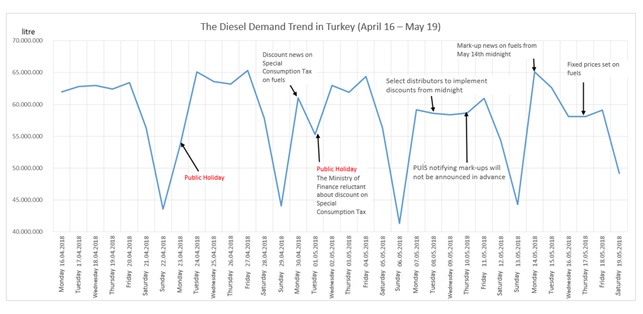 SUMMARY:
SUMMARY:
Daily availability of fuel demand data offers an important tool for the assessment of reactions to instant price movements in the energy sector. The period between April 23 – May 15 has been very hectic in terms of fuel pricing. We deemed it beneficial to include this period in the Q reports for future researchers.
METHOD:
The data was derived from General Directorate for Energy’s “Haftalık istatistik” (Weekly Statistics) reports. The news feed was compiled from a number of sources including “SonDakika” website where all diesel news is available chronologically.
ANALYSIS:
The per litre diesel demand in Turkey between April 16 – May 19 is as follows:

As demonstrated above, the diesel demand dips on Sundays since it is also used in transportation. Generally, this demand is higher on Mondays and Fridays compared to other days. The traffic congestion on these days reflects this.
Taking the public holidays into consideration first, both April 23rd and May 1st has shown considerable drops in demand. The reason behind the lower-than-expected demand on April 30th, 2018 can be interpreted as a merge of May 1st with the weekend to create one long holiday.
As the announcement of deduction from special consumption tax coincided with the public holiday, we’re unable to observe the wait-and-see behaviour clearly in consumers. News of deduction would have undoubtedly pulled the demand a little lower. The news that there will be no deductions, on the other hand, would have very likely been interpreted as a raise and could have affected the demand the day after. While none of these have concrete evidence, the difference in the period between April 30 – May 4 may very well be attributed to this.
On the other hand, the news that certain distribution companies might implement discounts at midnight between May 8th and May 9th doesn’t seem to have any discernible effect. In this case, it could be argued that the consumers have expected the discount to last a couple of days and demonstrated no specific increase in demand.
Petroleum Products Employers Union (PUİS) has announced that in the light of the increasing currency rates and oil prices, the organization will no longer announce any price increases in advance. This also doesn’t seem to have affected the demand.
The most interesting trend in this period is during May 14th – 15th. On 14th May, news of a mark-up spreads on the internet, prompting consumers to fill their tanks. What is interesting is that although the mark-up goes into effect at midnight on the 14th, we see a cluster filling up their tanks on 15th, wrongly assuming the news were announced in advance like before. This is difficult to interpret as the mark-up is already in effect at the time they decide to fill up their tanks.
On 17th May 2018, on the other hand, an adjustment on special consumption tax fixes the fuel prices, and as seen in the graph above, instantly calms what was a hectic period.
In gasoline demand, on the other hand, the more common non-commercial use, causes a shift higher on holidays (as opposed to diesel). However, the demand on Tuesday cannot be ignored. This means there is a heavy purchase even on the day following the mark-up. In fact, while the lowest demand of the week is on Tuesday – Wednesday, in the May 17 week Thursday can be seen as having the lowest demand. An unexpected demand in oil on Sunday, 13th May 2018, can also be observed clearly. A group of consumers are likely to have anticipated the price increase and filled their tanks in advance, because just in that particular Sunday the demand is much closer to that of Saturday.

CONCLUSION:
The first two weeks of May has been a very interesting and hectic period for the fuel industry in Turkey. It is important to remind those who mistakenly limit the energy sector to that of electricity that the effects of energy demand and prices can be observed best through fuel. One day, a similar graph can also emerge in micro-grid customers, which is an electricity storage system, as dynamic price reactions.
